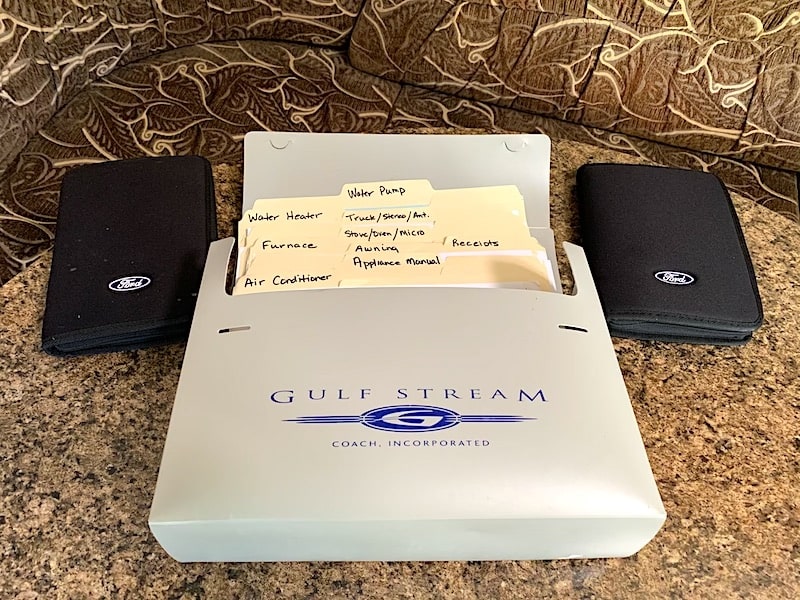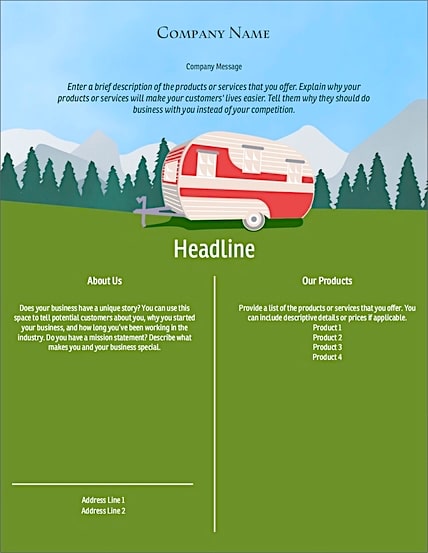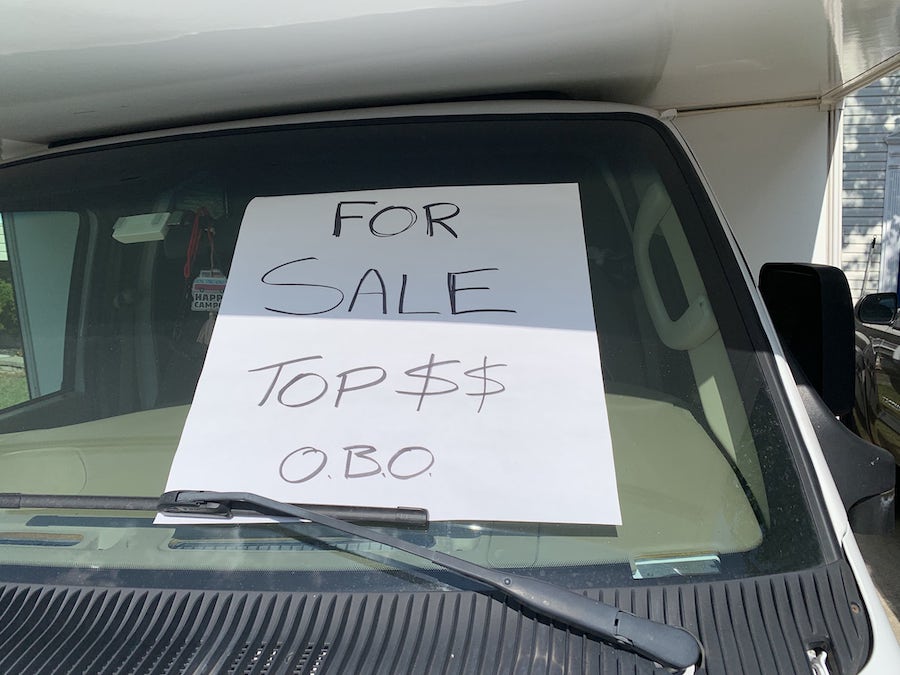Thanks for your support! If you make a purchase using our links in this article, we may make a commission. And, as an Amazon Associate, I earn from qualifying purchases. See the full disclosure here.
You’ve given your RV a name like it’s a member of the family. It’s given everyone unforgettable memories as you’ve crisscrossed the roads of the U.S. Now that the kids are grown and your financial situation has changed in retirement, it’s time to sell “Lucky Lucille.” We’ll show you how to sell your RV for what it’s worth- or more!
If a better name for your coach is “Drowning Dezi” due to financial challenges, we’ll show you some options for overcoming this hurdle and what to avoid. There are ways to get the best RV resale value or make your RV work for you whether you are selling it privately, online or through a dealer.
7 Best Tips to Maximize the Value of Your RV or Camper
1. Clean Your RV Inside and Out to Increase it’s Value
No one wants to buy a used RV. But a previously owned cream puff sounds much better. Clean your RV inside and out to present your RV to prospective buyers in the best light possible.
2. Get Your RV Inspected Before You Sell It
Having your RV inspected by a third party inspector and then making any repairs the inspector finds will definitely separate you from the pack and maximize the value of your motorhome or camper trailer. An inspection creates a feeling of transparency and trust with buyers. And you can make any necessary repairs so your buyer doesn’t have to make them. People pay more for the convenience of not having to do anything extra like make repairs or replace things.
3. Have All Paperwork Handy Including Service Records
Showing buyers that you have all of the paperwork for your RV and its components is a great way to make them feel more comfortable and secure in the process. Plus having all of your maintenance records shows how well you have cared for the RV.

4. Take Great Photos for your RV Sales Listing
The number one mistake we see when people sell their RVs is terrible pictures. If you aren’t good at taking pictures find a friend (or younger relative) who can take them for you. Here are our best tips for taking pictures:
- Use your cell phone and turn it sideways to get the best pictures
- The exterior of your RV should be the first image in the listing
- The very best interior shot of your RV should be the second picture in your listing (do not put pictures of storage bays or bathrooms at the beginning of your listing…put them last
- Be sure to include a floor plan of your RV in the mix and it should actually be the third or fourth picture you show. You can find floor plans of your exact year and model on line.
- Use a wide angle lense when taking pictures inside your RV. This is exactly what photographers do when taking pictures of a house to list for sale. Many cell phones have a wide angle lense built into them now so find someone with a newer model cell phone with a wide angle lense to take your pics.
- Do not zoom in too far on special features you want to show off…allow the viewer to see them in the bigger picture. Zooming in on a towel bar holder you installed does not look good.
- Create a video walk through of your rig if possible. Most people don’t do this but it will help you tomaximize your price because people buy what they can see.
5. Prepare Your RV Before You Show it to a Buyer
If someone is coming to look at your camper then get it ready for them. Plug it into shore power and turn on all the lights! If it’s hot outside turn on the AC and if it’s cold turn on the heat.
Make sure it smells good inside the RV so let it air out or add an air freshener. And be sure the beds are made neatly and everything is in its place. Just doing these simple things will make your RV more comfortable to visit and view.
6. Prepare a Flyer (in color) That Buyers Can Take with Them
Take some time and create a flyer with an exterior color picture of your RV and then use bullet points to highlight the most important features of your RV for example:
- Fireplace
- Bath and a Half
- 2 AC Units
- Extra Large Fridge
- New Roof
- Upgraded Interior
Also be sure to include your name, email, and phone number on the flyer. Most people show up and look at an RV for sale and leave. They have no information to help them remember it. And after looking at a few RVs they all become a blur. Provide a flyer to help your prospects remember your rig.

7. Provide a Warranty to Protect the Purchaser from Future Repair Costs
This is a great way to maximize the selling price of your RV because you can provide the buyer with a warranty that will cover any repairs that might pop up in the next year. Real Estate agents do this all the time when they sell homes so why not do the same thing when selling your RV?
You can find some great warranty coverage specifically for RVs through a company called Wholesale Warranties. Their warranties are 100% transferrable to the buyer and they provide peace of mind.
The RV Market: A Seller’s Perspective
Do you remember what it was like when you first bought your RV? Your dreams of adventure-filled trips made it challenging to keep a level head. You’re head was swimming with information, but you didn’t have the wisdom you have today. It’s hard to remember that mindset because of the attachment, memories, and emotion tied to your RV.
Buyers will have some form of that “magical wonder” like you had when you first started. Most want a turn-key situation where they can pack up and hit the road. To sell your used RV, you’ll need to clean, make repairs, and shine brighter than the rest of the crowd. This may require putting some time, money, and effort into preparing it to sell.
And you will need to take better photos of your RV than the competition too! So many people take terrible pictures or put their pictures in the wrong order, or worse yet don’t take the time to straighten up and merchandise their RV before taking their pictures. Pictures are worth a thousand words and they, along with video, will do more to sell your RV than even price!
There are some truths to the RV selling process that may be hard to swallow. Once you know and understand them, you’ll have a realistic perspective that you can use to determine the best way to move forward with selling your RV.
Depreciation Will Decrease the Value of Your RV Almost Immediately!
There’s no way around it; the average RV depreciates 20% in its first year (from its MSRP, not selling price). Depending on the brand, each year, it will continue to lose value between 10-30% after that. Some brands like Airstream have the best resale value due to their brand recognition, low mass production, and more than 75% of them are still on the road. Yet a 10-year-old Caravel will be thousand’s less than a new one even in peak condition.

Collectors would pay the highest price for this 1939 GMC Futurliner since only nine still exist. More common RVs that are 20 or more years old will have significantly lower prices than initially purchased. A better example would be a 1995 Fleetwood Bounder. The M-38ZW model on the Ford chassis originally was had a suggested list price of $81,173. 26 years later, the average retail range was between $9,800- $11,800.
How to Determine Your RV’s Price
1. NADA Price Guide
You’ll find that 99% of all RVs follow the depreciation of the Fleetwood Bounder. There is a Kelly Blue Book for RVs. The National Automobile Dealers Association (NADA) is the guide book RV dealers use as a starting point when determining the value of an RV. RV dealers have inspection managers and/or departments that inspect the coach for any areas of concern or repair issues that need attention. When selling, knowledgeable buyers and dealers will know about this website.
It’s okay to use the NADA guide to base your selling price. As you’re cleaning your RV up, do your own inspection to see what problem areas need addressing. Even the little things can affect the value. You may want to have a professional RV inspection conducted if you have a more expensive RV to get the best value.
2. Compare to Other Listings
Another way to zero in on a target price to sell your RV is to compare it to others. Websites like RVtrader, RVT, Craigs List, and others list thousands of units across the country. You’ll see listings from dealers and private sellers. Make sure you look at multiple listings to determine the average price.
3. Regional Favorites and Time of Year
The third factor is your local area and time of year. With a little research, you’ll see where specific RV categories are more popular. For example, in the western states, toy haulers are hot sellers. The desert and mountains give ATV and other motorized adventure toy enthusiasts plenty of opportunities to crush it on the trails.
Like cars, RVs have a high and low selling season. February through April are the peak months when people buy RVs. Dealers are cleaning out the previous year’s models to make room for the new models. Manufacturers promote their new model year products starting at the Tampa RV show in late January and many others.
September- November, those with RVs are getting ready to winterize and store their coaches for the winter. People looking to buy may begin their research in the fall with plans to buy after the winter thaw. The best way to sell your RV by owner is to stay with the pack.
Don’t worry about trying to compete with the RV dealers. Regularly, more than half of RV sales happen through private owners. Buyers will choose a used RV if the coach is in good shape and meets all of their needs and wants.
RVBlogger Pro Tip on Paperwork: When it comes to the RV’s paperwork, make sure you have all of it. You’ll want it together in a folder, well organized and complete. If you never received certain documents or they’re lost, there are ways to obtain duplicates. Here’s a checklist of documents buyers will want to see:
- Title and any additional paperwork used for the titling process
- Registration
- Maintenance Log
- Maintenance Receipts
- Owner and Component Manuals
- All Purchase Receipts
How To Sell an RV With a Loan
There are three main ways to sell an RV. You can sell it privately, go through an RV consignment business, or use it as a trade-in at an RV dealer. In each situation, the biggest concern usually boils down to having a clean title. If you still owe money to the lender who financed the RV, you must solve this before you can sell.
When you trade in your RV to a dealer, they can wrap the current loan balance into the new RV’s finance deal as long as you’re not borrowing more than 110% of the new coach’s purchase price. Remember, RVs depreciate as bad or worse than cars. Banks and lenders consider them luxury items, so there aren’t as many lending programs for higher-risk lending.
People who need to sell are often in a position where they can’t sell because they can’t afford to pay off the RV loan. The coach’s depreciation puts them in a situation where they owe more money than what the unit is worth. Some have had to resort to a worst-case scenario by transferring the balance of the loan as a lien against their house.
There is something to consider for those reading ahead and haven’t purchased their RV yet. Try to put down as much money as possible. The less you are financing, the better you’ll be when it comes time to sell. RV lenders are asking for 20% down on average (10% for excellent credit scores).
How Can I Get Out of My RV Loan
For those that are already under contract with their lender, don’t let fear take control. A short-term solution could be taking a bridge loan to pay off your RV. Once you receive the title from the lender (using something else as collateral), you can use the money from the RV to pay down a significant portion of the new loan.
Another option is renting your RV and using that income to pay off the loan. Peer-to-peer websites like Outdoorsy, RVshare and RVezy match renters in your area to owners like you. The renting company does the background checks and takes care of the business side of the deal. You can set terms like smoking preference, pet restrictions, and other considerations. You can also offer extra conveniences like remote drop off or onsite setup for additional costs.
According to many sources, 2020 is seeing a 1000% rise in RV rentals. The RV Industry Association (RVIA) also said that 46 million Americans either went on or planned to go on an RV trip in 2020. Experts plan for 2021 to be another big year. Why not take advantage of this opportunity have your RV pay itself off?
Trade-In or Sell Your RV? That Is the Question…
If your ultimate goal is to upgrade or downgrade into another RV, you may be wondering if it’s better to trade-in or sell your RV. There are pros and cons to each scenario. Here are some key points to consider whether you should do a direct trade-in through an RV dealer or sell your current coach privately.
RV Dealer
- Minimal Preparation: Cleaning up the RV and fixing what you can is always recommended, but their trade-in team will perform an inspection. They will repair what’s needed to either resell it or send it to the auction.
- You’re Not Liable: If the dealer finds a repair problem you weren’t aware of, they can’t turn around and sue you. One of the documents you sign states that they’re taking full possession of the RV, and you cannot be held liable for any present or future problems.
- No Tax Consequences: RV dealers take the tax hit. According to the IRS, if you sell your RV privately for a profit, you’ve received income even if you turn around and buy another. When you trade-in your RV, you don’t have to declare that income.
- Not Being Virtuously Patient: When you sell privately, it could take a few months. At the RV dealership, you hand over the keys to your current coach and close the metaphoric book on it.
Privately Selling
- Higher Sale Price: Selling your RV on your own will usually generate a higher price. RV trade-in values are generally lower than what you can get on your own due to the various costs dealers need to cover. They also need to make money off the resale, so they need to wrap those costs into the sale price.
- You Control the Sale: Since you’re selling the RV on your own, you determine how to market it through the various online media, print ads, etc. You also get to decide who to sell it too. If it comes down to a choice between multiple potential buyers, you get to pick.
RVBlogger Pro Tip on Selling Privately: When it’s time to accept payment, let the buyer know that you’ll accept verifiable payments. Cashier’s checks, money orders, and other third-party forms of payment will protect you and your buyer. They create a legally binding paper trail, and a secured entity guarantees the funds.
Check out this Video from Matt’s RV Reviews about How to Sell Your RV for Top Dollar!
Buying an RV the Second Time Around
We hope you have a successful selling process with your current RV. If you’re planning on buying a new (or new to you) coach, we know that this buying experience will be different from your first. You now have a lot of wisdom to draw on. To avoid a bad situation down the road, consider these questions:
- If you’re financing, can you put more money down to lessen the impact of depreciation?
- Are the features in the bigger unit you’re looking at worth the extra money?
- What is the difference between this year and last year’s model? Can they locate one, and how much can you save by purchasing last year’s model?
- You have a good idea of upkeep and travel expenses. How comfortable will the monthly payments be? How often will you be able to travel in your current financial situation?
- How well will the RV evolve with the changing needs of your family? Will your children or grandchildren have space to be comfortable?
The RV lifestyle is an enjoyable one. You don’t want to get into a situation where you have to work hard to afford it; you can’t go camping. Congratulations on starting or continuing the lifestyle. Happy Trails!
Related Reading
Is Airstream Classifieds Really Free? How to Buy or Sell Your Airstream Using Airstream Classifieds
Travel Trailer Depreciation: What’s My Travel Trailer Worth?
Is There a Kelley Blue Book for RVs and Campers?
Make Money By Renting Out Your RV
Brian Newman – Author and Full Time RVer
Although he’s from Motown, Brian Newman is a legacy RVer that grew up on I-75. He, and his wife have enjoyed the full-time RV lifestyle since 2017.
Like John Madden, he hasn’t “worked” in years because he gets to write about his passion. When he’s not working, he supports his daughter’s dog rescue efforts and disability causes.


